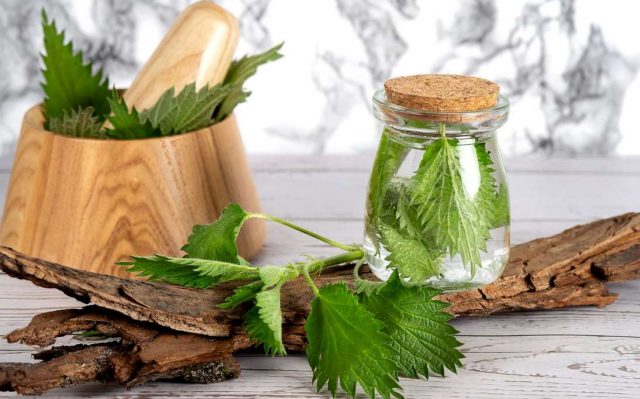For hundreds of years, people from different cultures have been using stinging nettle to address a wide range of health concerns. The same practice is present today, as well. Many people swear by stinging nettle, and you’ve probably come across claims it can help with specific problems, including those affecting prostate. Is stinging nettle really that powerful? Read on to learn more about the health benefits of this plant.
What is stinging nettle?
Stinging nettle, or Urtica dioica, is a plant growing in Europe, North America, and Africa. This plant is well-known for its pointed leaves with fine hairs. The leaves and stems of stinging nettle contain irritating chemicals that cause skin irritations when you come into contact with them.
Stinging nettle is abundant in vitamins, minerals, and other nutrients. It’s a good source of vitamins C, K, and B, carotenoids, and minerals such as iron, selenium, manganese, calcium, and others.
6 benefits of stinging nettle
The use of stinging nettle for medicinal purposes persists today, after thousands of years. People use stinging nettle because it allows them to take care of some health concerns naturally. Below, you can see some of the most significant benefits of stinging nettle.
1. Supports prostate health
Stinging nettle is one of several plants that promote the health and function of the prostate gland. Evidence shows that stinging nettle has the potential to alleviate lower urinary tract symptoms associated with benign prostatic hyperplasia or enlarged prostate. In other words, it can reduce incomplete emptying of the bladder, urinary urgency, and frequency.
Stinging nettle works alone or in combination with other plants and herbs for the management of enlarged prostate. The effects of this plant are comparable to those of the medication finasteride.
The mechanisms through which stinging nettle works for BPH require further research. Studies show this plant can prevent the conversion of testosterone into dihydrotestosterone (DHT), which could shrink the prostate. Studies also show that stinging nettle can lower PSA levels, meaning it could be beneficial for the management or prevention of prostate cancer.
2. Diabetes management
Consumption or supplementation with stinging nettle could help people with diabetes to manage their condition more effectively. Phytotherapy Research published a paper that found nettle supplementation significantly reduced fasting blood sugar levels.
Scientists concluded this plant could be helpful for people with type 2 diabetes. In traditional medicine, stinging nettle was used as an anti-hyperglycemic agent.
3. Management of erectile dysfunction
Men with erectile dysfunction (ED) may want to give stinging nettle a try. Ancient Greeks, Romans, and even Native Americans used stinging nettle to stimulate blood flow and support erectile function.
It helps maintain erectile strength or manage ED by normalizing hormone levels, and this plant can increase nitric oxide production. Nitric oxide is a vasodilator that relaxes blood vessels, which is necessary for the engorgement of the penis. Plus, stinging nettle could boost sperm motility and count.
4. Lowers blood pressure
People with hypertension may benefit from stinging nettle supplementation. The plant could reduce blood pressure through several mechanisms.
First, it stimulates the production of nitric oxide, which functions as a vasodilator. Improved circulation helps lower blood pressure.
Second, the stinging nettle contains chemicals that act as calcium channel blockers, which reduce the force of contractions to relax your heart.
Third, stinging nettle is a natural diuretic, meaning it helps the body eliminate excess salt and water.
All the abovementioned effects can help manage high blood pressure.
5. Hay fever management
Hay fever can be frustrating for most people, but stinging nettle could be helpful. Supplementation with stinging nettle can reduce symptoms such as sneezing and itching. According to one report, 57% of patients considered stinging nettle an effective remedy for relieving allergy.
The benefits of stinging nettle for managing hay fever and allergies could be down to its potential to decrease the amount of histamine the body produces in response to allergens.
6. Arthritis relief
Millions of people have arthritis, which causes joint pain, stiffness, and limited range of motion. Supplementation with stinging nettle, or its consumption, could help relieve symptoms of arthritis.
Stinging nettle exhibits anti-inflammatory effects, which is important because osteoarthritis, rheumatoid arthritis, and other forms of arthritis are associated with inflammation. Taking stinging nettle regularly can alleviate pain linked to arthritis.
Other health benefits
Besides the positive effects mentioned above, stinging nettle could also help manage anemia, and urinary tract infections, and also aid in healthy skin, nails, and hair.
Stinging nettle also supports eye, heart, kidney, and gallbladder health and reduces the risk of infections.
Possible side effects
Stinging nettle is generally safe to consume. Side effects are rare but may include:
- Urinary issues
- Stomach problems
- Diarrhea
- Rashes or hives
- Sweating
This plant may interact with medications such as blood thinners, diabetes medicines, heart disease drugs, and medications for high blood pressure. If you’re taking these medications, consult a healthcare provider before taking stinging nettle.
Handling fresh stinging nettle requires caution because it can harm your skin. When it comes in contact with your skin, stinging nettle may release various chemicals such as formic acid, leukotrienes, histamine, serotonin, and acetylcholine. These chemicals diminish when the plant is processed, so eating cooked stinging nettle is perfectly safe.
How to consume stinging nettle
You can consume stinging nettle on its own (just not fresh), or you can use it as an ingredient in various meals. Make sure to cook or steam the nettles first to destroy their hair. Some people dry stinging nettle and use their leaves to make herbal tea.
Their stems and roots are also edible, and you can add them to soups, stews, stir-frys, and even smoothies. If you plan to use the stinging nettle plant, keep in mind it grows from early spring through summer. Ideally, you should harvest stinging nettle when it’s small, not more than a foot tall.
Besides consuming the stinging nettle plant, you also have the option to use it as a dietary supplement. There are tons of stinging nettle root supplements available online and in drugstores. Also, it is present with other ingredients for managing certain health problems.
Final Thoughts
Stinging nettle has been around since ancient times. All this time, people have been using it for medicinal purposes. Indeed, the health benefits of stinging nettle are numerous. Consumption of this plant or taking supplements can support prostate health, improve erectile function, manage diabetes, lower blood pressure, and so much more. You can use the plant itself or take supplements, which come in tablet or capsule form.
Author Bio
Ben’s Natural Health is the world’s first high-quality, all-natural, scientifically proven clinical supplement company. Their motto is to combine holistic healing with modern science.
Ben has brought together a team of naturopaths, nutritionists, and medical researchers to help him create real, side-effect-free solutions to serious metabolic health conditions.
References
- Effects of stinging nettle (Urtica dioica).
- 5alpha-reductase: history and clinical importance.
- The Efficacy of Stinging Nettle (Urtica Dioica) in Patients with Benign Prostatic Hyperplasia.
- The glycemic control of patients with type 2 diabetes.
- Effects of Urtica dioica supplementation on blood lipids, hepatic enzymes, and nitric oxide levels in type 2 diabetic.
- Nitric oxide in hypertension.
- Calcium channel blockers.
- Acute diuretic, natriuretic and hypotensive effects of continuous perfusion of aqueous extract of Urtica dioica in the rat.
- Randomized controlled trial of nettle sting for treatment of base-of-thumb pain.
- Meeting Facilitation: How to Make It Engaging - 10/15/2024
- What to Do After a Truck Accident: A Comprehensive Guide - 10/15/2024
- Choosing The Best Local Pet Care Providers: A How-To - 10/15/2024





